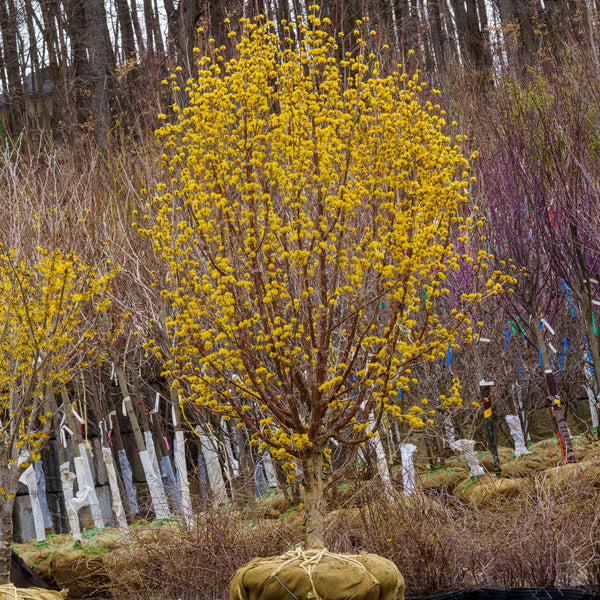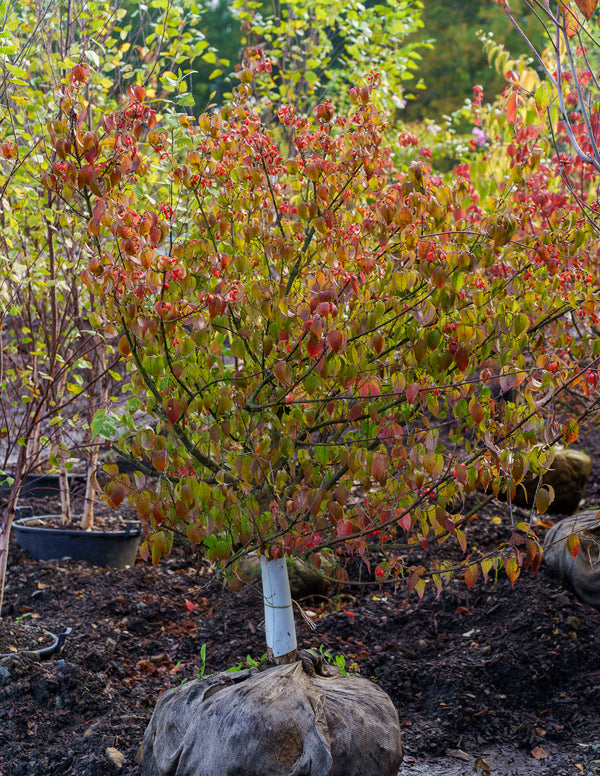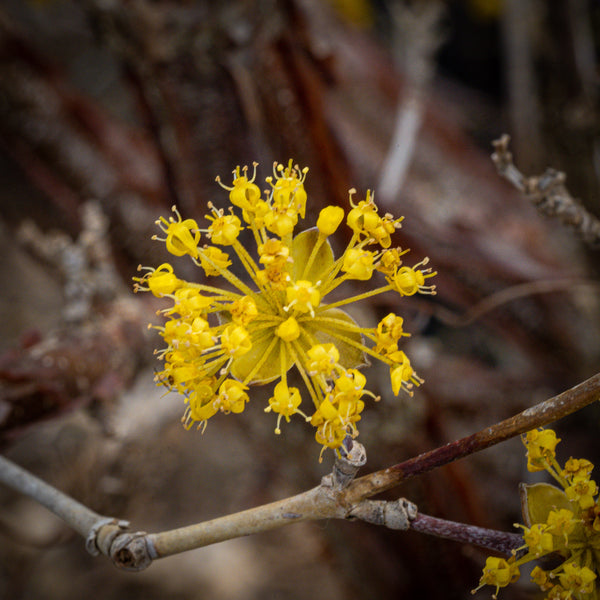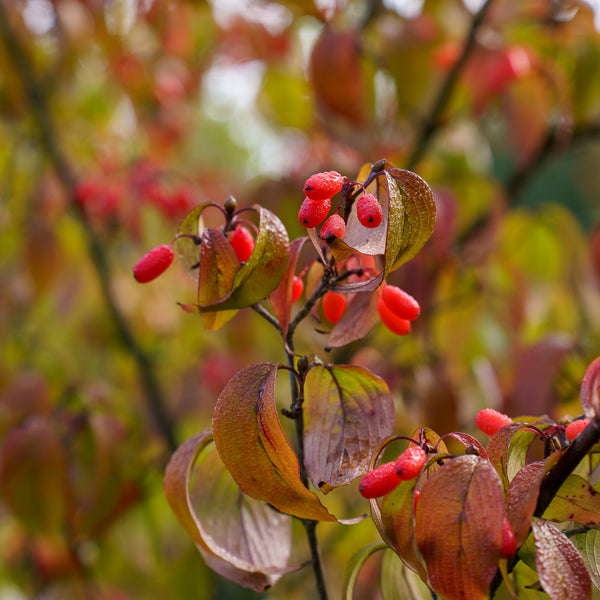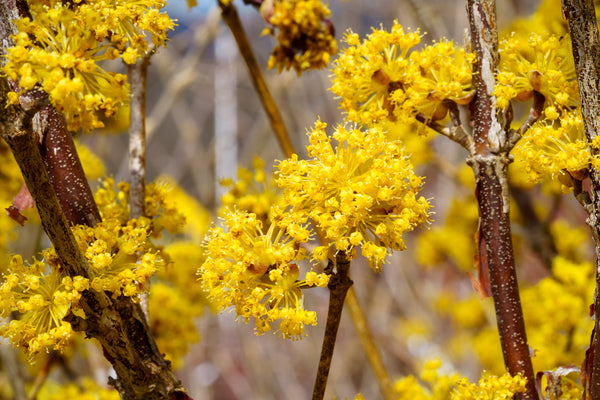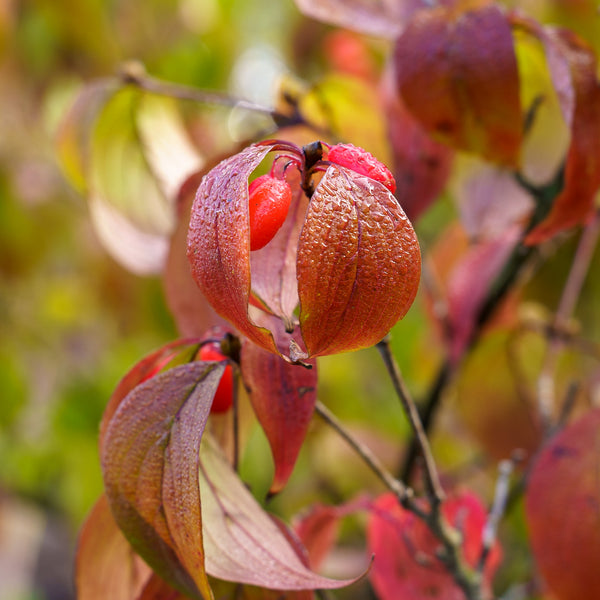Japanese Cornelian Cherry
Japanese Cornelian Cherry (Cornus officinalis)
Japanese Cornelian Cherry (Cornus officinalis) is a four season small tree or large shrub celebrated for very early, bright yellow flowers on bare branches in late winter, glossy red cherry like fruit in late summer, handsome exfoliating bark, and warm orange to red fall color. With a naturally rounded, multi stemmed habit maturing 15 to 25 feet tall and wide, it brings reliable structure and off season interest to courtyards, front foundations, and mixed borders.
Distinctive Features
Clusters of tiny, starry yellow blossoms appear weeks before most shrubs leaf out, providing early pollen for awakening pollinators; lustrous, elliptic leaves follow, then abundant, oval, translucent red drupes ripen for ornamental display and culinary use. Mature stems reveal patchwork bark in cinnamon, gray, and tan, adding texture through winter.
Growing Conditions
- Sun Exposure: Full sun to partial shade; best flowering and fruiting in full sun.
- Soil: Well drained loam is ideal; adaptable to clay or sandy soils with good drainage.
- Water: Moderate; keep evenly moist during establishment, then water deeply but infrequently; shows fair drought tolerance once established.
- USDA Hardiness Zones: 4 to 8.
- pH: Tolerates slightly acidic to slightly alkaline soils.
- Mature Size: Typically 15 to 25 ft tall and wide; can be kept smaller with pruning.
Ideal Uses
- Focal Point: Early bloom and peeling bark create a four season centerpiece.
- Specimen or Small Patio Tree: Multi stem form fits courtyards and entries.
- Hedging and Screens: Dense branching provides year round structure and privacy.
- Wildlife and Pollinator Gardens: Very early flowers feed pollinators; fruit is relished by birds.
- Edible Landscape: Tart fruit for preserves, syrups, and infused beverages.
Low Maintenance Care
- Watering: Water regularly the first 1 to 2 seasons; reduce frequency after rooting in.
- Pruning: Prune just after flowering to shape or thin; remove crossing or congested shoots to showcase bark.
- Fertilizing: Top dress with compost in early spring; apply a light, balanced fertilizer if growth is weak.
- Mulching: Maintain a 2 to 3 inch mulch ring to conserve moisture and moderate soil temperature; keep mulch off the trunk.
- Cleanup: Collect fallen fruit where tidiness is important near walks or patios.
Why Choose Japanese Cornelian Cherry?
- Very Early Bloom: Sparks the garden in late winter when color is scarce.
- Four Season Appeal: Flowers, fruit, exfoliating bark, and fall color in one plant.
- Adaptable and Durable: Tolerant of varied soils and urban conditions with minimal pests.
- Pollinator and Bird Friendly: Supports early insects and provides late summer fruit.
- Manageable Size: Fits small landscapes yet makes a substantial, elegant statement.
Cornus officinalis delivers unmatched late winter bloom and year round character in a compact tree form, offering dependable structure, wildlife value, and subtle elegance for front yards, courtyards, and mixed borders.
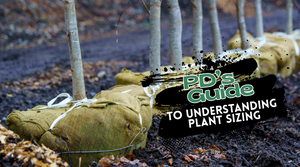
OUR SIZING
Not sure what 2 inch B&B or 30 Gallon Clump really means? This guide breaks down all our plant size terms so you know exactly what to expect, whether you're ordering online or picking up at our nursery. From caliper measurements to container volumes, we've decoded our system to help you shop with confidence.

Plant Detectives Shipping Guide
Nationwide plant shipping made easy. Learn how we ship trees, shrubs, annuals and perennials. No order too big or too small. Fast, careful, and contractor-friendly.

